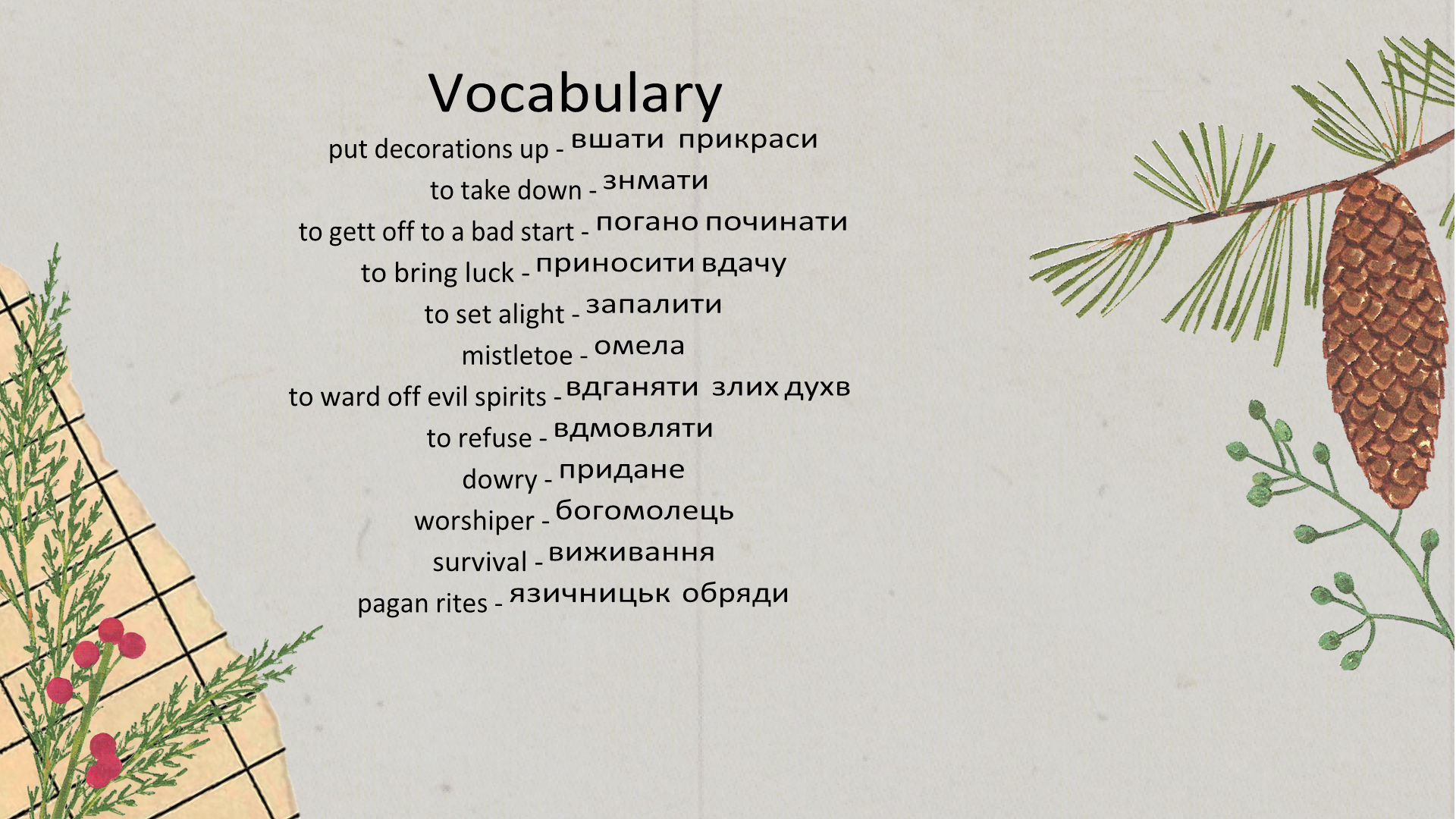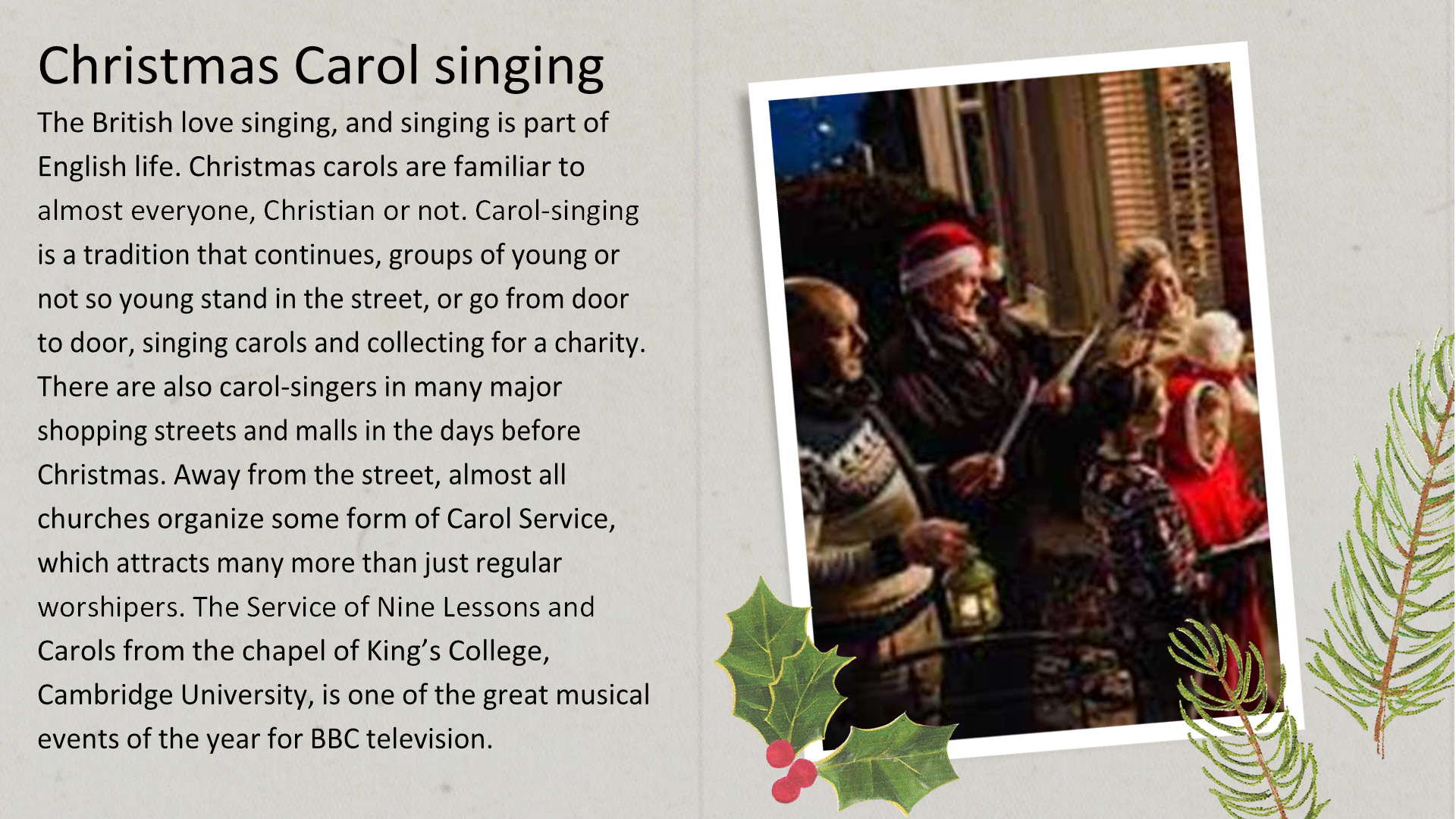Презентація "Christmas Traditions"






The tradition of hanging mistletoe in the
Mistletoe house goes back to the times of the ancient
 Druids. It is supposed to possess mystical powers which bring good luck to the household and ward off evil spirits. Today, kissing under the mistletoe is a great tradition that appears to have first caught on in the 18th century among servants in England before spreading to the middle classes. As part of the early custom, men were allowed to steal a kiss from any woman caught standing under the mistletoe, and refusing was viewed as bad luck.
Druids. It is supposed to possess mystical powers which bring good luck to the household and ward off evil spirits. Today, kissing under the mistletoe is a great tradition that appears to have first caught on in the 18th century among servants in England before spreading to the middle classes. As part of the early custom, men were allowed to steal a kiss from any woman caught standing under the mistletoe, and refusing was viewed as bad luck.
The tradition comes from a folk tale which tells the story of a
Hanging Christmas nobleman whose wife had died, leaving him penniless and thesole parent to their three daughters. Left with no money for a stockings dowry (which was an integral part of finding advantageous
 marriage suitors at the time), the nobleman was concerned for his children’s opportunity to marry well. Without a sizable dowry, no one of equal wealth and status would be interested in marrying them, and with nothing to inherit, they would be left destitute. Hearing of this father’s dilemma, Saint Nicholas came to their family home and filled the girls’ stockings, which were hanging above the fireplace to dry, with solid gold spheres so that they would be able to marry after all. Versions of this quaint tale have been circulating for decades, each featuring their own twist, but regardless of the specificities, this story has continued to fuel Christmas decorating for hundreds of years.
marriage suitors at the time), the nobleman was concerned for his children’s opportunity to marry well. Without a sizable dowry, no one of equal wealth and status would be interested in marrying them, and with nothing to inherit, they would be left destitute. Hearing of this father’s dilemma, Saint Nicholas came to their family home and filled the girls’ stockings, which were hanging above the fireplace to dry, with solid gold spheres so that they would be able to marry after all. Versions of this quaint tale have been circulating for decades, each featuring their own twist, but regardless of the specificities, this story has continued to fuel Christmas decorating for hundreds of years.
The tradition of the Christmas tree is an ancient tradition that goes back a long way in time. It probably originated in pagan rites to celebrate the survival of nature in winter. The
Christmas Tree modern tradition began in Germany, spreading throughout
 the Christian world, and in particular in Protestant countries, in the 18th and especially the 19th century. Prince Albert, the German husband of Queen Victoria, brought the tradition to England in the 19th century; it then spread quickly to the point where decorated Christmas trees have now become the classic symbol of Christmas – even more so than Nativity scenes. For most Britons, Christmas would not be Christmas without the tree (real or artificial) in the house. Every city, village, neighborhood, pub, department store, and many small shops, too, has its own beautifully decorated tree. In London, the huge Christmas tree in Trafalgar Square is given each year to the city by Norway, in a tradition that began in 1947.
the Christian world, and in particular in Protestant countries, in the 18th and especially the 19th century. Prince Albert, the German husband of Queen Victoria, brought the tradition to England in the 19th century; it then spread quickly to the point where decorated Christmas trees have now become the classic symbol of Christmas – even more so than Nativity scenes. For most Britons, Christmas would not be Christmas without the tree (real or artificial) in the house. Every city, village, neighborhood, pub, department store, and many small shops, too, has its own beautifully decorated tree. In London, the huge Christmas tree in Trafalgar Square is given each year to the city by Norway, in a tradition that began in 1947.


![]()
![]()
![]()
![]()

про публікацію авторської розробки
Додати розробку
